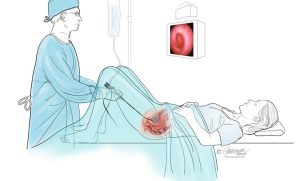Cystoscopy or in English Cystoscopy is a diagnostic method that helps the urologist to examine the bladder and the tube that carries urine out of the body. This process is one of the most important procedures for performing tests, surgeries and treatments related to the bladder. Through it, the specialist can obtain very useful information related to the health of the bladder, urinary tract, and possible problems of the individual’s prostate. What does cystoscopy mean? How is cystoscopy performed? Stay with us until the end so that we can examine the various aspects of cystoscopy in this article from the Kayvan Health Magazine.
In this article you will read:
What is cystoscopy?
The importance of cystoscopy
What is the use of cystoscopy?
How is cystoscopy performed?
The reason for performing cystoscopy
Postoperative care of cystoscopy
Risks and complications of cystoscopy
What is cystoscopy?
Cystoscopy is a type of bladder endoscopy that allows the urologist to view and examine the patient’s bladder through the urethra. This process is done with a device called a cystoscope. The device in question is equipped with a lens and a light source and helps the doctor to examine the inside of the bladder and urinary tract. A narrow tube (cystoscope) with a lens is inserted into your urethra and directed to your bladder.
The urethra is a tube that carries urine from the bladder to the outside of the body. Your bladder is full of fluid. With this, the bladder is stretched so that the doctor can see the inside of your bladder closely.
After cystoscopy, you may initially have pain in the urethra and feel frequent urination and burning during urination for the first few days after the operation. These symptoms will improve within 1 or 2 days and you will be able to return to work and most of your usual activities.
The importance of cystoscopy
Some cystoscopes are equipped with other tools and equipment. This device is able to give the doctor valuable information about the urinary tract, prostate and bladder. Patients with prostate cancer should undergo cystoscopy before surgery.

Cystoscopes are divided into two types, flexible and rigid. In flexible cystoscopy, there is no need to completely anesthetize the patient. In this method, men and women can follow the process of the test with the local anesthesia of lidocaine gel.
Rigid cystoscopy is often performed under anesthesia, although it is also possible to perform it under local anesthesia. But due to causing more pain, especially in men, there will usually be a need for general anesthesia. Rigid cystoscopes are usually between 5.7 and 7.3 mm in diameter.
What is the use of cystoscopy?
Cystoscopy is used in many cases. Diagnoses such as possible problems of the urinary tract, prostate and bladder are usually performed using a cystoscope and the subsequent treatment processes are followed. A patient may visit a urologist for various reasons.
One of these cases is urinary incontinence. In some cases, a person’s concern about the presence of blood in the urine or the feeling of pain during urination prompts him to see a urologist. Urinary tract infections and problems related to bladder stones, bladder cancer and other cases of this category are also other reasons that may cause cystoscopy to be prescribed for the patient in order to identify the source of the problem.
Bladder tumors of the velvety type, which cannot be detected by any other means, are easily detected by cystoscopy. Patients who need to undergo prostate surgery must undergo cystoscopy before surgery. Bladder inflammations can be diagnosed completely by cystoscopy.
Among other problems of old men, we can mention problems related to the prostate and prostate enlargement, which can also be diagnosed by cystoscopy surgery. In some cases, based on his discretion, the specialist may use ureteroscopy in addition to cystoscopy in order to evaluate the condition of the tubes out of the kidney.
How is cystoscopy performed?
Cystoscopy is possible, performed in the examination room and with the help of local anesthesia for the urethra. In the other case, this procedure is performed in the clinic and the patient is injected with sedation.
Another option is to perform the procedure in a hospital under general anesthesia. It was mentioned that in cystoscopy, a device enters the bladder through the urethra. Cystoscopy gives the doctor valuable information about the urinary tract, prostate and bladder.
